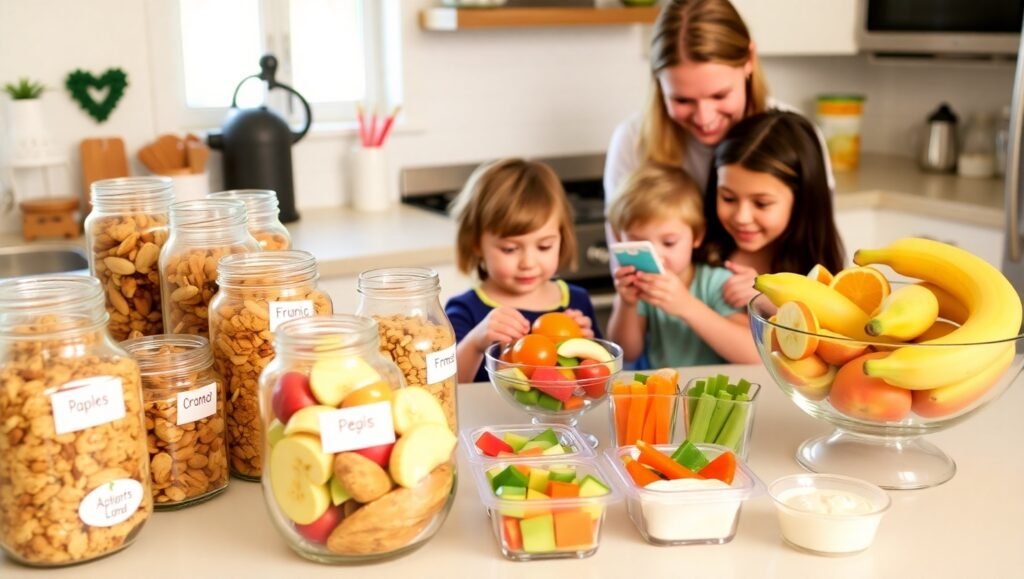
Your Family Would Like to Develop Healthier Eating Habits: Simple Tips for 2025
Establishing a healthier family diet is a crucial step on the way to the promotion of well being. By the year 2025, all you need will be to make minor changes to your eating habits to create a considerable effect on your health. The following are some of the interesting tips that can enable your family to adopt a healthier food culture within the home.
Start With a Family Food Plan
A weekly family meal plan can help make it easier to shop at the grocery store and prepare meals. Carve out a time per week to discuss meals with the family. Have each person offer their favorite foods with healthier ones being included. This creates a sense of individual responsibility and makes all feel like they are part of it.
Make Healthy Snacking Easy
Keep junk food out of your house. Rather, stock up on healthy snacks. Here are some great options:
- Apples, bananas and berries are fresh fruits.
- Hummus or yogurt dip along with vegetable sticks.
- Whole grain crackers/popcorn.
- Nuts and seeds
Having these snacks displayed in places where they are easily seen can increase the chances of the family members opting to eat healthier food items during the day.
Involve everybody in the cooking process.
Preparing meals as a family could be very informative and entertaining. Give children the opportunity to assist with age-related chores in the kitchen. Washing vegetables, stirring pots etc make them more interested in food and cooking. When children are at the level of helping to make it, they are likely to eat. And it is a great lesson to show them how to eat well.
Be Mindful of Portion Sizes
In developing healthier eating habits, it is important to understand the portions of food. Educate your family to pay attention to their bodies. Use smaller plates when serving food to contain portions. This makes all people slow down on their eating and know when they are full. Wary too of second servings; wait an hour or two, rather, to see whether you are really hungry or not.
Develop a Family Dinner Routine.
During and after dinner, eating a family meal is one of the best methods to bond with family and encourage healthy eating. Eat together, a few times a week. This time is to talk about your day and tell stories. It is a great idea to make mealtimes enjoyable so that healthy eating can become a routine in your family.
Encourage Hydration
Water plays a vital role in health, though families tend to forget about drinking enough water during the day. Have water bottles at home and promote drinking of water rather than sugary beverages. Turn it into a game: who can drink the most water per day and as a reward, they can have a healthy snack.
Model Healthy Habits
Your family is expecting you to act as a role model. By showing them good eating behaviors, they will imitate these behaviors. Be excited about exploring new fruits and vegetables and eating balanced meals. Discuss the advantages of these options in a manner that will appeal to them. Children will have a better chance of developing a positive attitude towards healthy foods when they see you eating them.
Find New Recipes Everywhere.
Every year, you will experience different culinary arts and dishes that will be health conscious. Choose a new recipe every week to spend time as a family. This does not only provide variety to your food, but it also makes the cooking process enjoyable. Take advantage of these opportunities to teach the family members about the ingredients and how they are healthy.
Limit Processed Foods
Meats are processed items; they are convenient and tend to be full of sugars, bad fats, and preservatives. Focus on consuming as many processed foods as possible by choosing whole and natural foods. When shopping, attempt to remain on the edges of the grocery store where fresh fruits and unprocessed foods are normally found.
Set Healthy Goals Together
Establish realistic family health objectives. It can be as simple as trying a new vegetable every week or trying to cut down on sugar, but having shared objectives can be very encouraging. Mark your steps along the way and have fun as a family, reminding yourself that eating healthy is a worthwhile journey.
Healthy eating as a family does not have to be a chore. With small, consistent changes, you can develop a culture of health and wellness that will leave a positive impact on everyone. Make the trip towards a healthier diet a family affair, and keep in mind that no step is wasted!
Why It Matters to Plan Your Meals to Eat Healthier as a Family

Meal planning is an important component of setting and sustaining healthier family lifestyles. Planning meals helps to benefit families in many ways that extend beyond healthy eating. By putting together a plan of what your family will consume, you are opening the door to improved nutrition, less food waste, and less time spent shopping groceries. The following are some tips that will help you on your meal planning journey as a family.
Begin with An Evaluation of Your Family Needs
Assessing individual dietary needs of the family members, before getting into the depths of meal planning, is a good idea. This includes considering:
- Sensitivity/allergy to food.
- Food experience.
- Examples of nutritional objectives include the loss of weight or gaining muscle.
You can make a meal plan that all will enjoy by understanding what your family needs and what they will need to eat to fulfill their nutritional needs.
Make a Weekly Menu
Writing a weekly menu is easier to get you picturing what you are going to make each day. To create a plan that is easy to follow, follow these steps:
- Decide which day of the week to work on your menu, preferably a day when you are not so busy.
- Add different kinds of proteins, grains, and vegetables to make the meals interesting.
- Use theme nights like Meatless Monday or Taco Tuesday, to make decisions easier.
Engage Your Family in the Process
Get your family members to participate in meal planning to make it an entertaining and joint venture. This also may prompt them to sample new foods. Here’s how to engage everyone:
- Gather as a family at least once a week and talk about food ideas and preferences.
- Ask family members to propose recipes or dishes that they would like to explore.
- Allow children to assist in the selection of vegetables or fruits as part of shopping.
Prepare a Grocery List
After identifying your menu, now you need to make a grocery list. This is essential in keeping things in check and cutting down on impulse purchases. These are the tips that can help you maximize your shopping:
- Shop faster by group (production, dairy, grains).
- Look in your fridge and pantry to be sure you aren’t shopping with duplicates.
- Keep that list in hand when you are shopping in order to remain within your budget.
Batch Cooking and Prepping
Preparing a large quantity of food over the week saves time and the stress associated with getting meals ready. Consider these strategies:
- Spend some time (a couple of hours) on the weekend preparing huge amounts of grains, proteins and vegetables.
- Prepare ingredients you will use in the store in transparent containers.
- Invest in freezer friendly meal containers to freeze individual portions to use on busy nights.
Flexible and Adaptable
Life is unpredictable and meal plans must at times be altered. Be adaptable by being able to change. These are ways to make it work:
- When an intended meal does not take place, replace it with another meal during the week.
- Keep some fast food recipes at hand in case of emergency.
- Imagine alternative uses of the leftover ingredients to prevent waste.
Explore New Recipes
Do not be shy about trying new dishes of other food cultures. This not only makes your family more diverse in what they eat, but also makes lunch fun. Search for:
- Recipes in online and cook books.
- Healthy cooking social media pages.
- Cooking applications that will give you meal suggestions depending on your preferences.
Organizing your family meals ahead will be the first step towards eating healthier. Planning your meals ahead will help you make more healthy eating choices, as well as cut down the stress that usually comes with last-minute meals. Also you will be developing a good relationship with food that can last a lifetime.
Making time to plan meals will increase accessibility to healthier options and make them more enjoyable to the whole family. Be open to the process, engage all and be amazed as healthier eating habits flourish in your home.
Fun and Creative Ideas on how to engage kids in making healthy meals

It is not only important to get kids engaged in the preparation of healthy meals as it would teach them good life skills but it would also make the mealtime more pleasant. Children who are involved in cooking love the food that they consume. The following are just a few playful and imaginative ways to make cooking a family thing.
Make Cooking a Game
Make it a game when cooking to capture their interest. For instance:
- Recipe Relay: divide into groups, time yourself to find out which team can collect ingredients the quickest.
- Blind Tasting: Tie a bandage on the eyes of older children and ask them to guess the ingredients in a dish.
- Chopped Challenge: Set up a cooking challenge where each child must create a meal using a selection of ingredients.
Incorporate Storytelling
Stories about family recipes can be told and a stronger connection can be made. When preparing any food, discuss the history of the dish or give personal observations regarding it. This gives children a chance to know the importance of the meal and gives them a sense of pride in the cooking process.
Grow Your Own Ingredients
The beginnings of a small garden – even a couple of pots – can get the kids excited about cooking. Children are fascinated with plant life and like picking and eating it at the family table. Here’s what you can grow:
- Herbs: Basil, parsley, and cilantro are easy to grow and can enhance any dish.
- Vegetables: Carrots, tomatoes and peppers are also good to plant and even better to eat after growing them.
- Salad Greens: Lettuce or spinach are fast growing and they add a fresh taste to your food.
Educate them in Safe Cooking
Kitchen safety is critical. Educate your children on how to use kitchen utensils including:
- Washing hands prior to commencing the cooking process.
- Applying the proper knives according to their age and prowess.
- Stove and Oven safety.
Check safety prior to cooking. Reminders need to be fundamental to create lifelong habits.
Food is a reward for Imagination
Allow your children to be creative, by letting them play with colors and shapes. You can:
- Make fun food shapes out of fruit and vegetables.
- Roll out sandwiches or pancakes with cookie cutters to make fun patterns.
- You should encourage them to get used to combining flavors, such as spices or putting sauces on their food.
Include Kids in Planning Meals
Get your children involved in planning the meals. Here’s how:
- Ask them what they like as wholesome food and make a note.
- Get them to read and choose new recipes to share.
- Make it a family menu night so everyone can plan the meals of the week.
This will encourage ownership and enthusiasm towards the weekly meals. Having a voice makes your kids more likely to eat what is on their plate.
Visit Cultural Foods
Show your children different cultures by way of food. One country per week, find out what is cooked traditionally there, and prepare a meal. Not only will you get to learn about various cuisines, but also educate kids on diversity and the significance of a healthy diet.
Make it a Family Bonding Time
Cooking is a wonderful thing to bond upon. Take this time to talk, laugh, and make memories to remember. You may find that your children share with you about their day as you chop vegetables together!
Children should be brought into the kitchen to develop an interest in healthy eating. With these fun and creative strategies, you can have a good and enriching cooking ambience. In addition, your family would probably adopt life-long healthy eating habits. Sharing meals not only leads to tasty dishes on a table, but to developing strong family relationships and valuable traditions.
Understanding Nutrition Labels: Making Informed Choices

This is a valuable skill that anyone wishing to make informed food choices must understand nutrition labels. At the grocery store, you may be overwhelmed with signs telling you about nutritional information. You might be asking yourself what all that stuff is and how it concerns your health. But deconstructing this information can make you feel more in charge of what you eat. Here is a more detailed look at the process of understanding nutrition labels and healthy decisions.
Nutritional Facts Overview
Each packaged food substance contains a nutrition facts label on which important details about this item are displayed. The key elements you will usually come across are these:
- Serving Size: This is used to denote the amount of the food that is taken as a serving. It is an important component to pay attention to because this can influence all other nutritional values.
- Calories: The amount of calories per serving will enable you to watch your energy consumption.
- Macronutrients: This involves fats (total, saturated and trans fat), carbohydrates (total and sugars) and protein. They combine to affect the health of your diet.
- Micronutrients: Vitamins and minerals such as Vitamin D, calcium, iron and potassium are usually listed. They are essential to general health and wellness.
- Daily Value (DV): This percentage is used to give you an idea of how a nutrient in a serving is contributing to your daily intake in a 2,000-calorie diet.
How to Read Serving Sizes
One of the most important sections of a nutrition label is its serving size. It gives you the percentage of the food that you ought to consume to make the information that is written on that label to count. To illustrate, when eating one cup of food, make sure you multiply the calories by two and the amount of nutrients by two when eating two cups of the same food. Portion control is always a good idea, helping to control weight and meet the desired results in the diet.
What are Fats, Sugars and Protein?
These and other fats, sugars, and proteins have different effects on health:
- Fats: Choose healthy fats, such as nuts and avocadoes, and should avoid saturated and trans fats, which have been associated with heart problems.
- Sugars: Intend to eat less added sugar in your diet. Refined sugars are not as good as natural sugars (fruits contain them).
- Protein: Protein supplies are required to repair muscles, and the most appropriate sources are lean meat, legumes, and dairy products. Look for large quantities of protein when you are body building or recovering.
Identifying Hidden Ingredients
The list of ingredients featured on the label is priceless. Product ingredients are normally listed in descending order of abundance. This will enable you to stay away foods that have a lot of additives or unhealthy ingredients. Sugar (in any form) as one of the first few ingredients may be a good reason to find an alternative.
The Importance of Fiber
Fiber is a part of a healthy diet. Seek out foods containing an adequate dietary fiber. Foods high in fiber may also assist in the maintenance of digestive health and in the process of helping you to feel fuller. Find food items that contain fiber of 3 grams or more per serving.
Additional Tips for Making Informed Choices
In addition to knowing the fundaments of nutrition labels, remember about the following points:
- It is best always to compare labels on similar products to discover the healthiest alternatives.
- Make sure that you are purchasing fresh products by checking the expiration date on the checks.
- Be aware of false information in the packaging, such as sugar-free or all-natural which are not necessarily healthy.
- Ask about products that are fortified with additional vitamins or minerals to supplement the nutrient that may be deficient in the diet.
Also, be sure to remember that you need to consider your own particular dietary requirements, including allergies and any medical issues, when deciphering nutrition labels. And, when in doubt, a nutritionist can help to explain the complicated information regarding nutrition.
When you read and comprehend nutrition labels, you become informed and able to make healthier food choices on behalf of your family. Pay attention to dinners and snacks which involve fresh ingredients and try to avoid highly processed products. The better informed you are, the more likely you can be successful in your dietary endeavors within your month to month wellness program.
The Role of Family Support in Achieving Healthier Eating Practices
Dining is not only a necessity, but also a chance that allows families to have time together and develop. Family support plays a key role when you want to have healthier eating behaviors. Changing your diet together means that you can support one another and establish a conditions that supports healthy living.
Inclusion of all family members in the decision-making process is one of the earliest steps towards healthier eating habits. Here are some powerful methods of creating a supportive environment:
- Speak frankly: Discuss the reasons why we all need to eat healthier. Spread the good news like more energy, better mood, and fewer illnesses.
- Create Common Objectives: Collaborate on establishing what your family means by healthier eating. Whether it is cutting down on sugar or increasing the number of fruits and vegetables consumed, set realistic targets that no one can dispute.
- Plan Meals Together: When people in the family are involved in the planning of meals they will tend to eat what is prepared. Involve all members in the process of selecting recipes, going shopping, and planning the weekly menu.
- Cook as a Family: Have fun cooking. Engage the children in cooking and educate them on helpful skills, as well as leave them with unforgettable memories.
- Promote Sharing: Provide an atmosphere in which relatives exchange their experiences and achievements when it comes to healthy eating. Mark achievements, such as trying a new vegetable or following a meal plan throughout a week.
The other essential element of family support is the promotion of positive changes as opposed to the punishment of unhealthy decisions. Indeed, this practice creates an environment of support instead of a guilt or shame-based environment. The following are other measures to be taken into account:
- Lead by example: Parents and guardians should be good role models in healthy eating. Children tend to imitate their elders when they see them making healthy decisions.
- Minimize Temptations: Minimize the number of unhealthy snacks you keep at home. In the absence of poorer choices, family members tend to switch towards healthier choices.
- Enjoy Healthy Eating: Engage in creativity in healthy eating. Make some colorful presentations using fruits and vegetables or compete with each other by creating the most innovative healthy dish.
It is important to have a balance. As much as we should be devoted to more health-conscious practices, be flexible. Do not overlook about the treats and special meals. The key is moderation. The following are some tips to help strike that balance:
- Have a Treat Day: Choose a day of the week on which the family can have their favorite luxury food without feeling guilty. This will aid in avoiding deprivation.
- Teach: Learn to eat in moderation. Rather than avoiding some foods, emphasis should be on the quantity and quality of foods.
- Think Positive: Keep the positive thoughts about eating healthy instead of calling it good or bad food. This realization will help in developing a healthier relationship with food.
Support is also achieved through the family rituals that surround food. Family meals can help to strengthen communication and build connections. Consider these practices:
- Eating with the Family: Make an effort of having at least one meal per day together. Bonding and discussions are welcome in this tradition, which creates a good environment around a meal.
- Make It Educational: Learn nutrition during meal-time. Talk about the advantage of different foods or their inclusion in the general diet.
Include more people in the celebration of the success of your healthier eating process as a family. Mark milestones with each other, be it trying a new healthy recipe, keeping meal planning going all month or just enjoying fruit and vegetables like never before. This appreciation boosts the positive family atmosphere you are building.
By paying attention to each other and engaging fully, changing to healthier eating habits will be easier and more pleasant. Along the way, as you keep collaborating, you should not only focus on the outcome, but do it as well. By creating awareness and a healthy attitude towards food in your family, you create a sustainable base to practice healthier eating habits.
Conclusion
It might seem like an overwhelming task to develop a healthier eating habit as a family, but with a few easy tips and a little dedication, it can be made very manageable. Planning your meals in advance, as part of your weekly routine, helps make eating healthy less daunting. This can not only save you time but also enable you to consciously add healthy foods that will benefit all people.
Involving kids in the cooking process can change the mealtime by adding an element of fun and involvement. When children are included in food preparation, they tend to experiment with new foods and adopt healthier foods. Also use imaginative methods of teaching them about colors, flavors, and textures that will make the experience fun at all ages.
Another important step towards making an informed choice at the grocery store is understanding the nutrition labels. You can educate your family about how to read and interpret those labels, so that they can make healthier choices every time. This information encourages improved long-term nutritional practices since they can learn to differentiate between different food options.
Family members can be a key factor to stay and improve these healthier eating habits. Congratulate, dine at the same table, and support one another in this process. With everybody on board, your efforts as a whole will result in a stronger family and healthier lifestyles.
Not only are these simple tips the first step towards healthier eating habits by 2025, but they also can lead to a lifelong passion with nutrition. It doesn’t need to be a grand gesture, just be consistent and soon you will find your family beginning to relate with food in a better way. Working together, you can build a healthier, happier future.